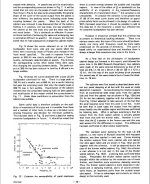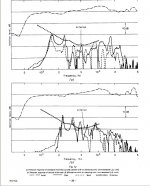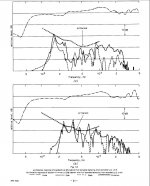Can one build a better non Ls3/5a cabinet based on T27s and B110s?
@midrange
If you choose dense damping mats like e.g. polymer-bitumen, "thinner wood and thick lining" is the better choice for a multiway cabinet, where the woofer also operates in upper bass and midrange.
Purely in terms of the acoustics of a damped panel, not practicalities or aesthetics;
"Malasian"plywood is much lighter than birch ply. With my limited experiments it seems to be more effectively damped than birch ply for a given amount of damping material. If making a damped cabinet, is it a viable material, at least from an acoustic point of view?
I am seeing a few posts alleging transparency to sound when a particular combination of resonant parameters are evident.
It is being claimed that thickness and weight have no effect when that "resonant" condition exists and the sound passes straight through.
Surely there must be limits on this condition.
Is a 300mm thick concrete wall "transparent" for sound waves passing through?
It is being claimed that thickness and weight have no effect when that "resonant" condition exists and the sound passes straight through.
Surely there must be limits on this condition.
Is a 300mm thick concrete wall "transparent" for sound waves passing through?
Recommendations for material and source (in the UK) for "dense damping mat"? Just Dedshete?If you choose dense damping mats like e.g. polymer-bitumen, "thinner wood and thick lining" is the better choice for a multiway cabinet, where the woofer also operates in upper bass and midrange.
Purely in terms of the acoustics of a damped panel, not practicalities or aesthetics;
"Malasian" plywood is much lighter than birch ply. With my limited experiments it seems to be more effectively damped than birch ply for a given amount of damping material. If making a damped cabinet, is it a viable material, at least from an acoustic point of view?
Also where does one find "Malasian"plywood (in the UK)? It doesn't appear to be readily available
I am seeing a few posts alleging transparency to sound when
a particular combination of resonant parameters are evident.
In case you are interested:
http://downloads.bbc.co.uk/rd/pubs/reports/1977-03.pdf
Measurements show a difference between 9 mm plywood (a)
and 18 mm plywood (b) without and with panel damping.
Attachments
I obviously can't understand what that is telling me about "transparency" for very thick and very heavy panels.
I asked about limits when the "rules" as have been stated no longer hold true.
I.e. is 300mm concrete "transparent" to audio signals?
If it isn't, then when do the rules change from transparent to attenuating?
I asked about limits when the "rules" as have been stated no longer hold true.
I.e. is 300mm concrete "transparent" to audio signals?
If it isn't, then when do the rules change from transparent to attenuating?
Wholly unnecessary apologies accepted . . . I hadn't noticed (blame last night's festivities) and had "read" what you meant 😉Blame last night's festivities. MALAYSIAN plywood is what I meant. Apologies.
None the less, I still wonder where you get Malaysian plywood (in the UK), Google doesn't help much.
I obviously can't understand what that is telling me about "transparency" for very thick and very heavy panels.
I asked about limits when the "rules" as have been stated no longer hold true.
I.e. is 300mm concrete "transparent" to audio signals?
If it isn't, then when do the rules change from transparent to attenuating?
I have not seen accelerometer curves for 300mm concrete. I suspect you haven't either.
What we do know is that heavy and dense materials, in the absence of effective damping, have multiple resonances. At these resonances the walls are highly transparent. Walls of realistic design (somewhat less than 300mm thick) have their resonances in the audio range and are not "cured" by virtue of being heavier and stiffer than the next guys cabinets.
Skyscraper designers know that all the steel and concrete in the world will still resonate and present an earthquake danger. The only cure is large tuned resonator masses and pools of viscous fluid.
The "rules" are very simple: have a high proportion of your wall mass from damping matter rather than rigid matter. This will lower the Q of your resonances and the frequency of resonance will not be of any importance.
Doesn't this make more sense than hoping problems will finally go away when silly cabinet dimensions are reached?
David S.
Surv1v0r
If I google Malaysian ply I get several hits. But try Far Eastern ply. There are loads for that. Similar stuff as far as I can see. I think my woodyard is fairly free and easy with the words they use. Probably "Far Eastern" is more normal and accurate.
If I google Malaysian ply I get several hits. But try Far Eastern ply. There are loads for that. Similar stuff as far as I can see. I think my woodyard is fairly free and easy with the words they use. Probably "Far Eastern" is more normal and accurate.
Many of the skyscrapers in Tokyo use mass counter weights and the buildings themselves rest upon an array of Firestone Airrides that are made in Noblesville Indiana.
"Have you ever auditioned some outdated, suitable only for playing in a van, LS3/5a variant?"
So these are the original white van loudspeakers???
I seem to be speaking in a non english form and as a result my question is not getting through.I have not seen accelerometer curves for 300mm concrete. I suspect you haven't either.
What we do know is that heavy and dense materials, in the absence of effective damping, have multiple resonances. At these resonances the walls are highly transparent. Walls of realistic design (somewhat less than 300mm thick) have their resonances in the audio range and are not "cured" by virtue of being heavier and stiffer than the next guys cabinets.
Skyscraper designers know that all the steel and concrete in the world will still resonate and present an earthquake danger. The only cure is large tuned resonator masses and pools of viscous fluid.
The "rules" are very simple: have a high proportion of your wall mass from damping matter rather than rigid matter. This will lower the Q of your resonances and the frequency of resonance will not be of any importance.
Doesn't this make more sense than hoping problems will finally go away when silly cabinet dimensions are reached?
David S.
I want to know what are the limits (or conditions) when "transparency" no longer fits with the rules as stated.
Assume a high Q, if that is a necessary condition for transparency.
When does the "wall" attenuate the sound wave, i.e quieter on the other side?
Try speaking American . . . or Elvish? 😉I seem to be speaking in a non english form and as a result my question is not getting through.
<snip>
I seem to be speaking in a non english form and as a result my question is not getting through.
I want to know what are the limits (or conditions) when "transparency" no longer fits with the rules as stated.
Assume a high Q, if that is a necessary condition for transparency.
When does the "wall" attenuate the sound wave, i.e quieter on the other side?
With the model as we understand it, there are no limits. No matter how thick you make the walls, there will be a frequency (multiple frequencies) where mass reactance and stiffness reactance cancel (our definition of resonance) and the cabinet is transparent.
That's why I keep referring to skyscrapers, no matter how massive and stiff they may be, they have distinct resonance frequencies that require damping to control.
I went with an architect friend who was looking at an old house. He was inspecting the brick and cement pillars that surrounded some windows and doorways. When he pounded on most of the pilars there was a mid frequency ring. On one there was instead a dull thud. "That ones cracked and will need to be repaired."
The pilars were thicker and way more massive than any speaker cabinet.
David S
Many of the skyscrapers in Tokyo use mass counter weights and the buildings themselves rest upon an array of Firestone Airrides that are made in Noblesville Indiana.
Really? I have an Aunt that still lives in Noblesville (Nobletucky she used to call it).
I was over not long after the Kyoto quake and had an interesting conversation with some American consultants. Some of the skyscraper solutions, I swear, were copied from Dual tonearms. Tuned, damped, counterweights.
David S
I will have to accept that, since I don't know any better.With the model as we understand it, there are no limits. No matter how thick you make the walls, there will be a frequency (multiple frequencies) where mass reactance and stiffness reactance cancel (our definition of resonance) and the cabinet is transparent.
..............
From that, it appears that when one makes the "wall" of appropriate dimensions such that the required "mass reactance and stiffness reactance cancel", then the wall is transparent to that audio frequency. There is no attenuation.
This leaves house building with a quandary.
How do we stop "hearing" the neighbours?
The whole mass and stiffness thing defies logic at first blush. I like to view it the way architectural acoustics people do. If I have noisy neighbors then I want walls with high transmission loss or TL. The best parameter for noise isolation is barrier mass. Acousticians refer to an ideal of the "limp mass barrier". That is think of making walls with heavy rubber sheet. You can make them thicker and they will become heavier, but because we have found some ideal limp material they will remain resonance free. It turns out that such a limp mass gives a transmission loss that climbs 6dB per Octave (every Octave we go up it becomes 6dB more effective as a barrier) and I can also raise the whole curve by doubling the mass per square foot, for a 6dB improvement.
Unfortunately my barrier is poor at DC and will have no isolation. I can add stiffness to give low frequency isolation and every time I double stiffness I will double my low frequency isolation.
This sounds great--combine high mass with high stiffness--but I have now created a resonant system. At some frequency the positive reactance of mass and the negative reactance of stiffness are equal in amount and opposite in phase. At that frequency we will have ZERO transmission loss or all the sound will get through (see attached Barlow curves). The only possible barrier to sound transmission is if there is loss in the system: i.e. damping material.
Here is a good web site that goes into the basics of wall construction with regard to transmission loss.
Noise insulation case
It give graphs for mass loss and shows some of the resonances that occur in walls and how they effect TL. Note that this is a curve of loss and higher up the scale is good. The bottom of the scale represents unwanted wall transparency.
Should we compare rooms to cabinets? (note, Cabinet = small cabin or room).
Wall transmission just looks at the simple case of one wall of our room. Speaker cabinets are fairly complex beasts with multiple resonances for each of the 6 sides and also complex coupling from one wall to the other via the edge joints. Still, the basics of mass and stiffness and damping and resonances all apply. Adding mass will move resonances down, adding stiffness will move resonances up, and at resonance we rely on damping to prevent total sound Transmission.
Regards,
David
Post 196
In architectural acoustics they worry about wall resonances and coincidence effects giving frequency bands of low transmission loss. The primary wall resonance is fairly low so adding stiffness never really helps. The mass law is the dominant principle. You can also have dual walls with staggered studs and no through connection. This represents a mass-compliance-mass system, essentially an LCL low pass. Even then, fibreglass is recommended to prevent resonances that allow transmission.
David S
I will have to accept that, since I don't know any better.
Sure we do. A 190 meter thick plywood cabinet will not pass audio to the same degree as a 0.0019 meter damped plywood cabinet whether a 19 meter cabinet has been tested or not.
Appreciate your bringing up the limiting case btw...
This leaves house building with a quandary.
How do we stop "hearing" the neighbours?
The Only homes I've been in where one can say and almost mean "I cant hear the neighbours." have been 3 - 600 year old stone / wattle and daub places - stone walls walls 18" - 24" thick.
My uncle Steven has such a place and, being a HiFi nut, it suits him and his neighbours well.
Does that mean that random rubble walls with lime based mortars and lots of air spaces, are impossible to build such that the required mass reactance and stiffness reactance will ever cancel !!!!The Only homes I've been in where one can say and almost mean "I cant hear the neighbours." have been 3 - 600 year old stone / wattle and daub places - stone walls walls 18" - 24" thick.
My uncle Steven has such a place and, being a HiFi nut, it suits him and his neighbours well.
Now what if we used a different type of lime mortar?
BTW, most of my external walls are 18" to 24" lime based random rubble and my neighbours have never complained to me.
Don't know what they say behind my back !
- Home
- Loudspeakers
- Multi-Way
- Can one build a better (non) LS3/5A speaker based on T27s & B110s?


